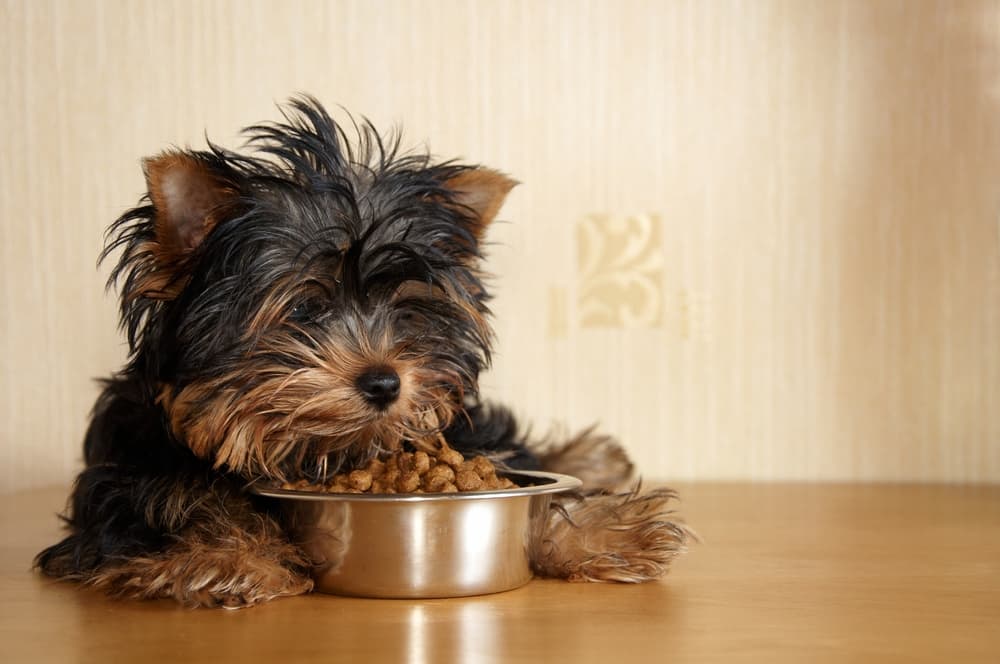When to Switch to Adult Dog Food: 5 Signs It’s Time

You might always think of your adorable puppy as your little baby, but before you know it, that tiny fluff ball will grow into a full-fledged dog! And though dogs never outgrow our hearts, they do outgrow their diet as they mature. If you’re wondering when to switch to adult dog food, you’re in luck. We’ve got all the information you need.
Knowing when to switch from puppy food to adult food is an important part of helping your pup develop into a healthy adult. It can also play a key role in preventing a wide range of health concerns, ranging from obesity to hip dysplasia and more.
However, since every dog matures at a different rate, knowing when it’s time to upgrade can be tricky. To guide pet parents, we’ve outlined five signs that can help confirm it’s time to switch, plus some tips for making the switch from puppy to dog food as stress-free as possible for you both.
Is Your Puppy Ready for Adult Dog Food?

Your beloved puppy isn’t just brimming with cuteness. Inside that energetic body, there’s a lot of rapid growth going on throughout puppyhood. That’s why puppies need a special diet that’s formulated to provide all the essential vitamins, minerals, and nutrients for healthy development.
Switching to adult dog food before your puppy is fully mature could derail your puppy’s healthy development. The challenge is that guidelines for when to switch to adult food are generally pretty broad.
According to Alex Schechter, DVM, founding veterinarian of Burwood Veterinary Urgent Care and Wellness Center, “Pet parents should offer their puppies adult dog food typically around 9-12 months of age for small to medium breeds and around 12-18 months of age for larger breeds.”
“The transition from puppy food to adult dog food depends on specific factors such as the puppy’s breed, overall health, and activity level. Different breeds have different growth rates, and they can reach their adult size at different ages,” he explains.
Puppy Food vs Adult Food

Food is food, right? Well, not when it comes to puppy food vs. dog food. Here are some key differences, as well as what to look for in an adult dog food once your pup is ready,
Difference Between Puppy and Adult Dog Food
Unlike jars of baby food and food for adult humans, most puppy food looks pretty similar to adult dog food, albeit with different packaging. However, beneath the surface similarities, puppy food and adult dog food are very different.
Puppy food formulas are designed to support rapid growth and development. “Compared to adult dog food, puppy food is calorie-dense and contains higher levels of protein and fat,” says Schechter. “It also has slightly higher levels of calcium and phosphorus, which is necessary for developing strong bones and teeth.”
Puppies also have smaller tummies than adult dogs. So they typically need to be fed smaller, but more frequent meals, throughout the day.
“In contrast, adult dog food has lower levels of protein, fat, and calories to maintain a healthy weight and prevent obesity,” he continues. “Adult dog food also contains fewer vitamins and minerals, as adult dogs have already gone through their critical growth and development period.”
Similarities Between Puppy and Adult Dog Food
Though puppies and adult dogs require different nutritional formulas based on their stage of life, it’s worth remembering that some things remain consistent, no matter how old a dog is — such as their breed.
So when you’re thinking about making the big switch to adult dog food, don’t forget to take your dog’s unique breed needs into consideration.
For example, Hill’s Science Diet Large Breed Puppy dry dog food delivers a specialized formula designed to keep larger breed puppies, like Great Danes, from growing too quickly, which could cause bone strain and deformities.
While rapid growth is no longer a concern for such dogs once they reach adulthood, breed size can still impact their health. That’s why Hill’s Science Diet Large Breed Adult dry dog food contains glucosamine and chondroitin for joint health and mobility.
Similarly, small breed dogs of any age can appreciate the smaller bite-sized kibble pieces in Hill’s Science Diet Small Paws dry dog food, which is available in formulas designed to address the unique nutritional needs of small breed dogs, from puppies to adult dogs and seniors.
How Long is a Dog a Puppy?

All dogs are different — and we love them for that! But that also means there’s no one-size-fits-all answer about exactly when dogs stop being puppies and start being adults.
Generally, dogs can be considered adults when they stop growing, which can happen anywhere between the ages of 6-18 months old. But that’s a pretty wide window, and where your dog is likely to fall within that range often depends on their breed size.
Most puppies — large breed, small breed, and in-between — develop at approximately the same rate until they’re about six months old. That’s when growth in smaller breeds starts to taper off. As a result, small breed dogs are typically considered adult at 6-8 months of age. While larger breeds tend to keep growing until they’re 12-18 months of age.
Admittedly, this framework is still pretty broad. So if you’re still wondering, “When are dogs fully grown and ready for adult dog food?” here are some additional signs that can help you figure out if your dog is outgrowing their puppy diet.
When to Switch to Adult Dog Food: 5 Signs It’s Time
How long should a puppy eat puppy food isn’t a question you can answer with a precise date on a calendar. However, keeping an eye out for some telltale signs can give you a better sense of when your pup may be ready for a more mature diet.
It’s always a good idea to consult with your veterinarian before switching your pup’s food. But if you spot the signs below, it’s worth scheduling a call or visit with your vet to discuss it.
1. Your puppy has stopped growing

Once you know when your puppy should stop growing based on breed size estimates, stay alert for signs that confirm your dog’s growth is slowing or has stopped. These can be observational, such as noticing that your puppy has finally grown into those adorable oversized paws and gangly legs. But, ideally, you want to ensure your pup’s growth period has ended.
You can do this by comparing your dog’s weight to the breed standard weights set by the American Kennel Club (AKC). If you have a mixed breed dog, you can ask your veterinarian for help determining whether your dog has reached their mature weight for their general size.
2. Your puppy is gaining weight

As puppies approach adulthood, they no longer need the higher levels of protein, fat, and calories that puppy food contains to support rapid growth and development. At the same time, their energy levels start to decrease. This combination often results in excess weight gain, which is another sign that adult food would be a better fit for your pup.
Just be sure to confirm with your vet that what you’re noticing is indeed extra weight and not normal, healthy puppy growth.
3. Your puppy’s growth plates are closing

The growth plates in a puppy’s longer bones are made from soft cartilage that gradually hardens and turns into calcified bone as your puppy matures. While signs of skeletal growth plate closure are subtle and can only really be seen on X-rays, some pet parents may notice changes if they run their hands down their dogs’ rib cage. If you can feel a bump or “knob” at the end of the rib, your pup may still have some growing to do. If not, they may have reached maturity.
4. Your puppy isn’t as hungry

If your puppy is leaving food in their bowl, they could be ready to make the switch to adult food. Puppies’ energy levels also tend to decrease as they mature, which might mean your dog isn’t as ravenous as they used to be when they needed to fuel all their puppy antics.
5. Your puppy is experiencing stomach upset

“Diarrhea, vomiting, or other gastrointestinal issues can all indicate it’s time to switch your dog’s food from puppy food to adult food,” says Schechter. This could be due to higher levels of fat or protein your dog’s body no longer needs. However, digestive issues like diarrhea can be caused by many things. So it’s always best to consult your veterinarian so they can recommend the appropriate treatment.
How to Switch from Puppy Food to Adult Food

When you and your veterinarian determine it’s time to transition your puppy to an adult dog food, it’s important to do so gradually.
To help your dog’s digestive system acclimate to the new food, it’s best to introduce their new food over a week, following this schedule:
- Days 1-2: Feed 75% puppy food and 25% adult food.
- Days 3-4: Feed 50% each of puppy food and adult food.
- Day 5-6: Feed 25% puppy food and 75% adult food.
- Day 7: Feed 100% adult food.
Many pet parents choose to stick to the same brand of adult dog food as the puppy food they’ve been using, but you don’t have to do this if you’d prefer to try a different brand. Just be sure to choose a complete and balanced adult dog food formula that fits your dog’s unique needs, such as Hill’s Science Diet Dog Food.
“Many veterinarians often recommend Hill’s Science Diet as it is considered as high-quality pet food formulated to meet the nutritional needs of pets at different life stages and with various health conditions,” Schechter says.
Whichever brand you choose, check the feeding guidelines on your dog’s new food and make sure you’re feeding the recommended amount for their weight.
If your dog doesn’t want to eat their new adult diet or experiences any signs of gastrointestinal upset, such as vomiting or diarrhea, talk to your veterinarian to see if you need to try a different formula or simply extend the transition period.
It’s also a good idea to make sure all family members know that you’re transitioning to a new food and have one person in control of feeds.









